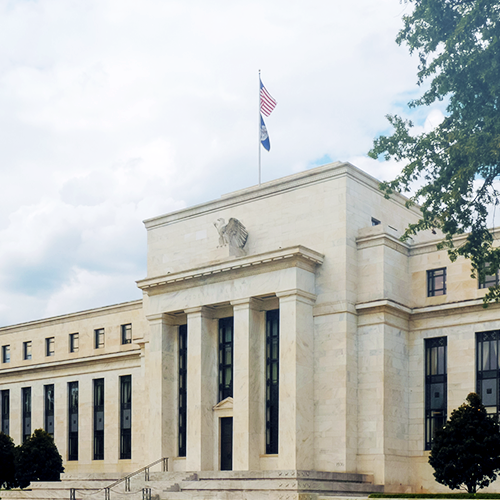.jpg)
October 2023
One More Quarter?
Will the final quarter of 2023 have the final quarter point increase?
Download PDFWe recently sat down with Dominic Nolan, CEO of Aristotle Pacific Capital, to get his insights into recent market moves, the resilient economy, the Federal Reserve’s new forecast, and opportunities in fixed income. We finished up with a speed round of questions and a personal reflection.
Market Performance: Total Return

Let’s start with market performance. What went right and what went wrong in September?
September was a weak month for equities and most of fixed income. Equity indexes were lower by about 5%. One of my takeaways is that it wasn’t sector rotation or a move between growth versus value, but general risk-off sentiment as most indices were down similar percentages. I think the anchor of the move downward was interest rates. The Bloomberg US Aggregate Bond Index (Agg) was down about 2.5% last month and down now 1% this year. Just a few days into October, it’s down another 1%-plus with Treasury rates hitting a 15-year high. I think the market is coming to grips with a “higher-for-longer” interest-rate environment.
10-Year Treasury Rates: Year-End Forecasts by Major Banks

The higher rates were really pronounced in the longer maturities. What do you think is going on?
Going into the year, seven major banks, on average, forecasted rates on the 10-year Treasury—which started 2023 at about 3.80%—to end the year at about 3.60%. It’s now 4.57% and the 30-year Treasury is now close to 5%. These are yields we have not seen since before the Global Financial Crisis. So, what’s happening? For one, the U.S. economy has been more resilient than many predicted. There has been a ton of supply coming in through 1) deficit spending and 2) quantitative tightening. There is a lot of technical pressure on Treasury rates. Labor has been resilient, thus resulting in inflation being more resilient.
How do you see the rest of the year playing?
In my opinion, unless something changes the situation meaningfully, pressure will remain on bonds, pushing rates higher. Although, I think rates are a little higher than they should be. Again, the current momentum is taking rates higher even though inflation has been lower. If investors chose not to fight the Fed, the yield curve should move higher.
What’s been the standout performance in the markets so far this year?
On the equity side, it’d have to be the large tech names, the Magnificent 7. On the debt side, clearly bank loans.
What has been the comeback story of year?
The Nasdaq Composite. It’s up more than 20% so far in 2023 after getting crushed last year.
Federal Open Market Committee Dot Plot

Now I want to get your thoughts on inflation and the Fed. What’s the Fed’s base case for the rest of the year and 2024?
Current odds for a hike in the fourth quarter sit at about 40%. In the September meeting, the Fed adjusted its forecasts via the “dot plots.” My takeaway from the recent dot plot centers on 2024. In June, the base case next year was three to four cuts, ending around 4.5%. Fast forward just three months later, base case is now 5% for 2024, which would mean around two cuts. As mentioned, today it is basically a coin toss on one more hike this year, but the Fed is indicating cuts in the later part of 2024. The Fed dot plots have been incorrect on many levels in the past, but it does give a base case of what they’re thinking.
The Fed signaled in September that a soft landing for the economy is possible. Do you think that’s too optimistic?
“Possible” is not optimistic. If they would have said “probable,” that would be optimistic.
Is the market starting to believe the Fed’s rhetoric?
I think the markets came around to the Fed’s signaling. Earlier this year, there was a big disconnect with the market expecting two to three cuts in 2023. The Fed’s rhetoric was pretty firm that there would be no rate cuts. Now the market is believing the Fed. This is why, to some extent, you’re seeing weakness.
When do you think the Fed will cut rates, and what will be the market’s reaction when they do?
I think the Fed cuts next year. To me, the cuts will be less impactful than the signaling since the market and the Fed are now expecting cuts in 2024. When that happens, in theory, the market should rally. But it will all depend on how this all unfolds.
CPI Category Importance and Year-Over-Year Percent Change

Let’s drill down a bit into the data. What are Consumer Price Index (CPI) inputs telling us right now?
CPI is up 3.70% year-over-year, but it’s more complicated than that. Housing represents almost 35% of CPI, and it’s up far above that average at 7.3%. Housing is a major factor in driving the CPI numbers. Food, which represents over 13% of CPI, is up 4.3% year-over-year. But other categories are below that 3.70% average: Energy is down -3.60% year-over-year, services are up 3.1% and commodities, excluding food and energy, are up only 0.2%.
If you were to strip away shelter, the rest of the components come in under 2%. If shelter rolls over, that will give the Fed room to pause and then start cutting rates.
2015–2023: Job Openings Rate – Total U.S.

Now how does employment factor into this discussion?
You’re seeking various employment data points now trending downward. For example, job openings spiked at 7.4% because of factors caused by the pandemic, but now it’s trending toward its historical average of about 4%. But will it return to 4%? That’s to be determined. On a more secular level, the country needs skilled labor. Boomers are retiring, which is technically disinflationary due to less spending. However, we as a country need more teachers, engineers, pilots, medical workers, etc. That tells me labor will continue to have more leverage than it did in the previous decade. That also means the cost of labor will result in stickier inflation.
Oil and Inflation

Oil recently topped $90 a barrel. Do you think gas prices will be the straw that breaks the consumers back?
Historically, oil prices have been highly correlated to CPI. If oil stays above $80, I think that’s going to make it difficult for CPI to get inside of the Fed’s target of 2% inflation. So if that makes it harder for the Fed to cut, it increases the chances of recession.
Let’s look at the economy overall. How’s it going?
The Atlanta Fed GDPNow currently forecasts GDP at 4.9% for Q3 2023. That’s a big number. I don’t think it’s going to be quite that high. The economy is showing resilience and dramatically outperforming relative to expectations going into the year.
“Atlanta Fed GDPNow” GDP Estimate for 2023

What kind of concerns do you have about the economy?
First, the consumer is running out of the COVID savings. This is especially true for lower-income consumers. Two, inflation is the No. 1 concern for most consumers, and you are seeing that flow through to a lot of these union negotiations. Given this, I’m interested to see if spending habits change. Will travel, dining or large purchases be reduced? Will they buy the new iPhone or just skip a cycle? Will they buy a new car? Will they go out less? All those little habits are going to be interesting to see over the next six to nine months.
On a scale of 1 to 10, how optimistic are you about the economy in 2024 and why?
A 3.5. Again, I think inflation is rolling over, but I think monetary policy is too tight at this time.
Yields Have Increased Significantly Since 2021

Let’s talk bonds. Where do you see opportunities in fixed income today?
Yields for the Agg now sit at nearly 5.5% and Treasuries are approaching 5%. If you step out a little bit and buy short-term debt, it gets you to 6%, which is amazing since 6% used to be the yield for high yield bonds just a few years ago. To get more than that, you’re going to have to speculate that rates are going to drop because you’re not getting compensated to go on the curve and wait. Another way to get more than 6% is to drop in credit quality and invest in high yield or bank loans. In this case, an investor is getting paid to wait. You may get paid an extra 400 or 500 basis points per year by doing this.
From the standpoint of opportunities, I will still stick to what we’ve been saying for the past few months. I like the barbell strategy: lower duration assets such as floating-rate loans and longer duration assets such as investment-grade bonds. If yields go up, trim a little bit of the short end and move out on duration, and vice versa if rates drop. We have seen these elements help balance the volatility.
Now let’s shift gears and go to the lightning round. First phrase: credit-card debt.
It’s been rising, and I think a reflection of the consumer spending through their savings and battling inflation.
New home sales.
If you were to speak to most homebuilding analysts, I think the big surprise has been the pricing of homes has been very resilient, but the transactions are down. For existing homeowners, it’s a very high hurdle to get them to move out given the cost of financing as well as the prices of homes. Home sales and inventory are more in the hands of homebuilders today because there’s so little existing inventory for sale.
The UAW strike.
Wages are up roughly 6% since COVID hit in 2020. Inflation is up around 20%. So, the autoworkers need a raise of roughly 14% to just be even with inflation. If you assume inflation will be running at 4% to 5% for the foreseeable future, that’s why the UAW is asking for a 40% on pay increase. Will they get that number? Probably not. But I think there’s a fair argument for at least a 20% raise. Now if labor gets more money, is that considered good or bad? For investors, increasing costs may not be viewed as good, but for the consumer, it’s good. In the end, it’s probably a little bit of both. That’s the beauty of the markets.
Netflix ending its DVD subscription service.
I didn’t know they still had a DVD subscription service.
This one is near and dear to my heart: Should NFL future Hall of Fame quarterback Aaron Rodgers retire?
I think the question really is: Should Rodgers come back and play this year? I think it will depend upon how many wins his new team, the New York Jets, have when he’s healthy again—let’s say four months from now. I think the number is about seven or eight wins. If the Jets’ record is in the neighborhood of 8-7 and they have a shot at a wild card playoff berth, I can see him playing. But if they are 5-10, why put Rodgers at risk? That’s an easy decision for me. But he should absolutely not retire.
Twix. All day. With that, let’s close with a personal reflection.
Fall is here, and I love fall. It’s a great time of year. The weather cools off, the leaves change, football’s back, and the baseball playoffs have started. As a bonus, my wife loves pumpkins and Halloween. So far this fall, I’ve gone to outdoor concerts, have dined al fresco, and visited the beach. I would just say to others, “Soak it up.” Winter is going to be here in a matter of weeks, so get away from the nonsense and get outdoors. That’s my two cents.
Definitions:
10-year Treasuries are bonds issued by the U.S. government and have a maturity of 10 years.
30-year Treasuries are bonds issued by the U.S. government and have a maturity of 30 years.
The Atlanta Fed GDPNow is a nowcasting model for gross domestic product (GDP) growth.
Bank loans (or floating-rate loans) are financial instruments that pay a variable or floating interest rate. A floating rate fund invests in bonds and debt instruments whose interest payments fluctuate with an underlying interest-rate level.
One basis point equals 0.01%.
The Bloomberg US Aggregate Bond Index (Agg) is composed of investment-grade U.S. government bonds, investment-grade corporate bonds, mortgage pass-through securities, and asset-backed securities, and is commonly used to track the performance of U.S. investment-grade bonds.
The Consumer Price Index (CPI) is a measure that examines the weighted average of prices of a basket of consumer goods and services such as transportation, food, and medical care. It is calculated by taking price changes for each item in the predetermined basket of goods and averaging them. Changes in the CPI are used to assess price changes associated with the cost of living.
A dot plot is used by the Federal Reserve’s to signal its expectations of future interest rate changes. In a Fed dot plot, each member of the FOMC is represented by a single dot, but each dot is anonymous.
The Global Financial Crisis (GFC) refers to the period of extreme stress in global financial markets and banking systems between mid-2007 and early 2009.
The Gross Domestic Product (GDP) growth rate compares the year-over-year (or quarterly) change in a country's economic output to measure how fast an economy is growing.
High-yield bonds (or junk bonds) are bonds that pay higher interest rates because they have lower credit ratings than investment-grade bonds.
Investment grade refers to the quality of a company's credit. To be considered an investment grade issue, the company must be rated at 'BBB' or higher by Standard and Poor's or Moody's.
The long end of the yield curve refers to the part of the curve that’s 10 years or greater.
Maturity is the date on which the life of a transaction or financial instrument ends, after which it must either be renewed or it will cease to exist.
Monetary policy is a set of tools used by a nation's central bank to control the overall money supply and promote economic growth and employ strategies
The Nasdaq Composite is a stock market index that consists of the stocks that are listed on the Nasdaq stock exchange.
Quantitative tightening (QT) (or quantitative hiking) is a contractionary monetary policy applied by a central bank to decrease the amount of liquidity within the economy.
The short end of the yield curve refers to the part of the curve that ranges from 0 to 1 year.
Treasury rates or yield is the effective annual interest rate that the U.S. government pays on one of its debt obligations, expressed as a percentage.
Volatility is a statistical measure of the dispersion of returns for a given security or market index. In most cases, the higher the volatility, the riskier the security.
Yield is the income returned on an investment, such as the interest received from holding a security.
A yield curve is a line that plots yields (interest rates) of bonds having equal credit quality but differing maturity dates. The slope of the yield curve gives an idea of future interest rate changes and economic activity.
Any performance data quoted represent past performance, which does not guarantee future results. Index performance is not indicative of any fund's performance. Indexes are unmanaged and it is not possible to invest directly in an index. For current standardized performance of the funds, please visit www.AristotleFunds.com.
The views expressed are as of the publication date and are presented for informational purposes only. These views should not be considered as investment advice, an endorsement of any security, mutual fund, sector or index, or to predict performance of any investment or market. Any forward-looking statements are not guaranteed. All material is compiled from sources believed to be reliable, but accuracy cannot be guaranteed. The opinions expressed herein are subject to change without notice as market and other conditions warrant.
Investors should consider a fund's investment goal, risks, charges, and expenses carefully before investing. The prospectuses contain this and other information about the funds and can be obtained by visiting AristotleFunds.com. The prospectuses and/or summary prospectuses should be read carefully before investing.
Investing involves risk. Principal loss is possible.
Foreside Financial Services, LLC, distributor.



